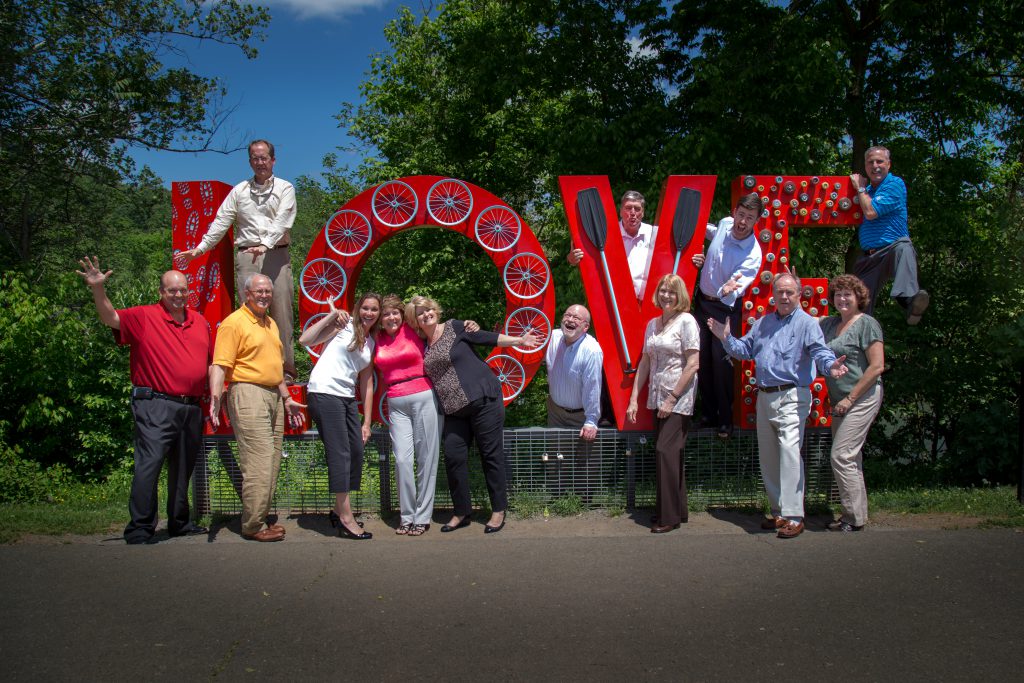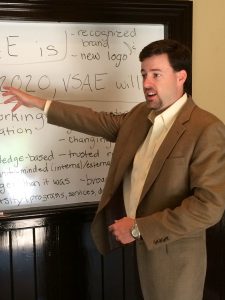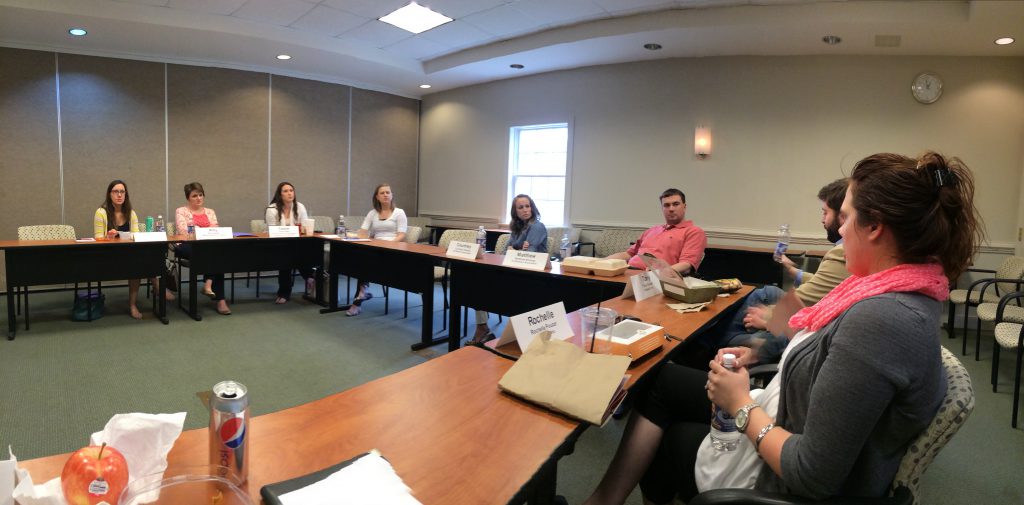How Do You Get to The Executive Director Position? Listen, Question and Learn
From the Corner Office: Brandon Robinson, CAE, VSAE

If you were to meet Brandon Robinson, CAE, in person, he’s likely to say, “Tell me your story. What can I learn from you? What should I know about your industry from the last 20 or 25 years?”
That relentless curiosity and desire to learn from other association professionals is what has driven Robinson, president of association management at Eisenman & Associates, Inc. and executive director of the Virginia Society of Association Executives (VSAE) from a job answering phones for an association to one of the top positions for a state SAE. Along the way, he has internalized several lessons about association leadership that he shared with Association Adviser during a recent chat.
In a time when so many Boomers are retiring and taking their hard-earned professional knowledge out of the boardroom and into retirement, Robinson emphasized that establishing mentor-like relationships is key for the next generations to build on the success the previous generations have built for their associations and their industries. Read on:
Association Adviser: Tell us about your path into association leadership.

Brandon Robinson, CAE: I fell into it! About 12 years ago I had just completed my master’s program and was in need of a job. I started out at a national association based in Washington, DC – just answering phones, but I made my way up through the ranks and fell in love with association work. Next, I got involved with ASAE and really enjoyed it. The association industry is such a great community.
I’m originally from Richmond, Va. and when my wife and I were looking to move back, an opportunity became available to work for Easter Associates, Inc., an association management company that managed the Virginia Propane Gas Association (VAPGA). While with Easter Associates I ran VAPGA, three other trade associations, and one professional society.
Then an opportunity opened at Eisenman & Associates, Inc. (E&A), which for the last 22 years has run the Virginia Society of Association Executives (VSAE). I initially came on board as VSAE’s vice president of professional development and communication, and became executive director when Rick Eisenman, CEO of E&A and the then-executive director of VSAE announced his desire to step back from the day-to-day management of VSAE to focus on growing E&A.
 AA: Did you follow a transition plan to ease your move into the executive director position?
AA: Did you follow a transition plan to ease your move into the executive director position?
BR: Yes. Our transition plan involved lots of conversations between me and Rick, and between us and VSAE’s board of directors. Rick and I started talking leadership transition with VSAE’s board in early 2015. I started building relationships with the board to make sure they were okay with the proposed change, and more specifically, with me as their new executive director. With a longtime client like VSAE – they have worked with Eisenman & Associates for 22 years – it’s very important to continually build and preserve trust.
Once the board was comfortable with the change, I spent the rest of the year working on the strategic and administrative duties inherent in the transition. Every week, Rick and I met to tackle something different: the board retreat, finances, membership updates, board policy, and so on. On January 1, 2016, I officially became the executive director of VSAE and have enjoyed the job tremendously.
I think I can attribute the smooth transition to my efforts to working on relationships with VSAE’s board members. From the start, I asked each board member what’s important to them regarding VSAE, what needs to continue, and what can change. My desire was to be as transparent as possible – to make sure they understood, “I’m going to be a different kind of leader than the last executive director, but I’m listening and working with you.” This is one of the major reasons why the transition was so successful. Another reason my transition was smooth was the hand-in-hand relationship I had and continue to have with Rick. Having the previous executive director only twenty feet away provides a tremendous resource to pass ideas by and get professional advice as well.

AA: What are the most important decisions you make as a leader of VSAE?
BR: The most important decision any leader makes are the questions you need to ask to get to a decision. My leadership style is not micromanagement. I ask my teams, “How would you solve this?” I also think to myself, what are the questions I need to ask that will prompt others to help make the decision? If I make all the decisions, I fish. But if I help others make decisions, then others learn how to fish, too.
AA: What leadership skills have been most valuable to you in your role as an association executive director?
BR: Three things: One; ask questions. Always ask questions. Leaders don’t have to have all the answers. But you should know what questions to ask. Why should we do it this way? Or that way?
Two: see things from another person’s perspective. Put yourself in a board member’s shoes, or a regular member’s shoes. How are they going to view this event, program, or initiative?
Finally, listen. When I came on board I took a listening tour with VSAE’s sponsors, supporters, internal team, and members. Talk less. Listen more
AA: Which is most important to VSAE: its mission, core values, or vision?
BR: We don’t prioritize one over another. Our focus is on mission and vision, which we just revised last year along with a new strategic planning process. VSAE’s vision is to make the association the best it can be. We want to be the gold standard of associations. We want our association professional members to say, “look at that. We want to be like that.”
Our mission is “Association professionals: connecting, learning, leading.” Our goal is to create an engaged community of association professionals focused on developing each other and enhancing the professionalism of the association management industry. When VSAE’s incoming president took the stage at our annual meeting this past May, he talked about his journey as a VSAE member. It was testament to the mission. He went from connecting with colleagues to learning from colleagues to leading colleagues as President of the organization. Talk about a volunteer leader living the mission.

AA: Do you set aside specific times to cast vision to your employees and other leaders?
BR: It’s a work in progress. Internally we talk about it regularly and everyone has a copy of the mission and vision in their office. We try to do the same with the membership, though it is a constant challenge.
AA: You served as chair of ASAE’s Young Professionals Committee for one year, in 2014-15. What leadership needs did you observe within the committee and within the larger young professionals audience, and how did you address them?
BR: One of the biggest things I learned as the Young Professionals chair was the importance of relationships. I think we did good work and I’m proud of what we accomplished that year, but when I look back and say, “What was the legacy?” it is the relationships I built and the things the committee has done since I completed my term of which I’m most proud.
Building bridges and relationships has been a key learning point in my career in the last few years. I’ve learned to focus on the people in addition to the work. Sometimes I think that lesson gets lost early on in association professionals’ careers..
AA: What were some of your accomplishments as ASAE’s Young Professionals Chair?
BR: Our big goal during my tenure was to integrate the “voice of YPs” into the broader ASAE strategic conversations AND create a stronger sense of community. The biggest accomplishment towards that first goal was not really something I did, though it was manifested in Tammy Barnes’ (vice-chair during my tenure) participation in the ASAE Leadership Retreat in Louisville in the fall of 2014. I thought her input was critical to some thinking about the job-task analysis and I think her being in that position to have that impact was a testament to the work of the committee.
One of the Young Professionals Committee’s biggest charges is helping encourage YP attendance at events like Annual Conference in August. One of the ways we did that was through the production of a YP Guide to Annual Conference. It was a one-pager we put together and got into the hands of YPs to help create a sense of community at the event. This was NOT my idea though during my year as chair we worked hard to get it into more hands and it resulted in one of the most energetic and well-attended YP receptions at the conference in Nashville, which is a good measure of how well we did creating that sense of community among YPs.
So, when I think about what the group accomplished during my time as chair, I reflect on the success we had integrating YP voices into broader strategic conversations and creating a stronger sense of community among YPs involved with ASAE. Otherwise, my goal as chair was to keep the momentum going from those who came before and set up the future groups for even more success.
AA: What is the biggest challenge facing association leaders today?
BR: Relevance. There’s so much noise and content out there, so much of everything, that associations being relevant is challenging. Those who have figured out how to be relevant have figured out how to be successful.
AA: What is one characteristic you believe every association leader should possess?
BR: Empathy. You must be empathetic. This goes back to being able to listen and see something through someone else’s eyes. A leader of an organization must understand where team members are coming from, where the board comes from, where members come from. You can disagree with them, but you must at least understand each other. Seek first to understand then be understood.
A leader of an organization must understand where team members are coming from, where the board comes from, where members come from. You can disagree with them, but you must at least understand each other.
AA: What is one mistake you witness leaders making more frequently than others?
BR: Biggest mistake leaders making is operating from fear or pessimism. I think our job as leaders should be to operate from optimism. We don’t need to fear failing or challenges. And there are hundreds of challenges for associations, but when you operate from a place of fear of those challenges, that begins to get you into a negative, reactive state. Our role as leaders, we need to be proactive.
AA: What are a few resources you would recommend to someone looking to becoming a better leader?
BR: Get involved in a local SAE. Wherever your local association is, there’s an SAE for you. Becoming a member of that community and gaining access to that professional network and source of leadership knowledge is so valuable.
Read, read, read. There’s so much good information out there, from companies, from practitioners, from consultants and from SAEs. The more you read the more opinions you’ll learn, and the better informed you’ll be. I published an article in VSAE’s newsletter one time. A member disagreed, and wrote me about it, so I published their response in the next issue. Enabling members to read both opinions helped them learn both sides of the issue more easily.
Lastly, build bridges. Build relationships. Those are key to leadership success.
AA: What are you doing to ensure you continue to grow and develop as an association leader?
BR: I follow VSAE’s mission in this regard: Connecting, learning, leading. I’m connecting with those who have gone before me in VSAE and ASAE leadership positions and trying to learn from them. If you talk with association leaders who have been in this community for a while, they all have someone they’ve known for years and who they trust they can call when they need an opinion or advice.
AA: What gets you excited to come into work every day?
BR: Doing all of this – getting to do all of this – all of the work for VSAE. Where I’m at currently is a product of every day before this. I’m excited about the future of our community – that keeps me going every day, too!

